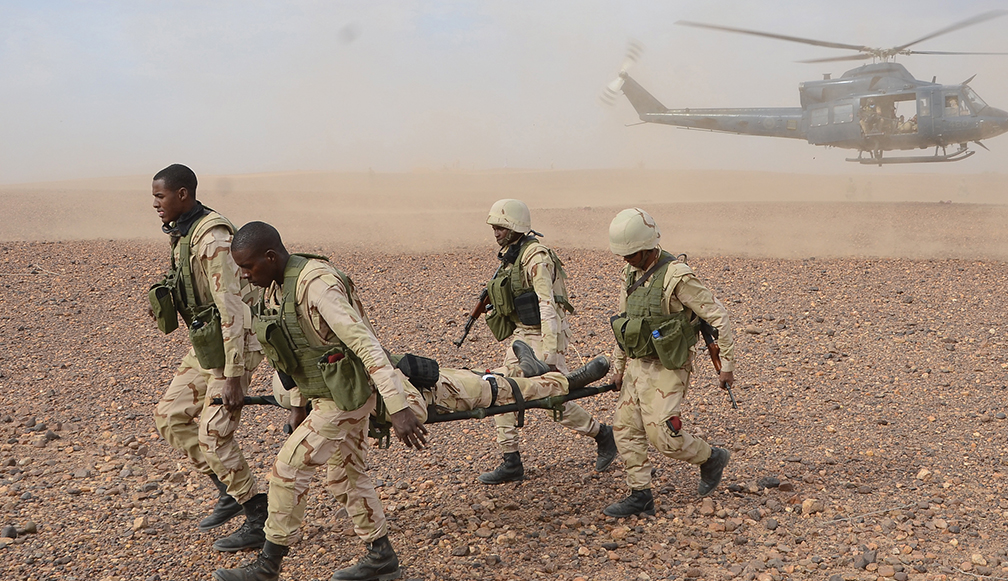Cessna 208 Flight Crews Use New Skills to Save a Life
ADF STAFF
The annual Festival de L’Aïr in Iférouane, Niger, draws crowds from throughout the nation’s northern region. Those attending the event celebrated rich Tuareg culture with music, singing and dancing.
Two men on their way to the festival never made it. Their SUV ran over an old land mine about 1 p.m. February 22. The blast tore through the SUV and amputated one man’s foot. The other passenger suffered trauma from the impact.
![Maj. Sidio Ka Ismael Ka, pilot [ADF STAFF]](https://adf-magazine.com/wp-content/uploads/2014/09/1341_clip-300x225.jpg)
Fortunately, two Nigerien military Cessna 208 airplanes were at an airstrip near the festival, and some of their crew members had taken months of intensive casualty evacuation (CASEVAC) training in the run-up to Exercise Flintlock 2014. Their training, quick work and ability to fly the injured to a hospital in Arlit may have saved a life.
“When we heard the story, heard of the bombing, we started preparing the Cessna, because the Cessna is made for CASEVAC,” said Maj. Sidio Ka Ismael Ka, the pilot who flew the two patients to Arlit.
The Cessna 208 typically seats 10, including crew members. But these two planes, which the United States donated to Niger, each can accommodate up to two medical litters if crew members remove some seats.
Once the two injured men were brought to the plane, Ka and the two crews sprang into action. They removed seats, strapped in a litter and hung an IV bag for the severely injured man. One of the two flight engineers, Sgt. Chef Ibrahim Moussa, tied a tourniquet around the man’s leg to stop the bleeding. The second passenger was able to sit upright during the 30-minute flight. The severely injured man underwent surgery and survived.
The successful response was the culmination of training that began in 2013. The United States trained about 30 people, including doctors, nurses, emergency responders and flight crews. The Nigeriens learned how to fly the Cessna 208s and took medical training. They learned ground staging for transport and how to configure medical equipment on the plane. From August to December 2013, each of three engagements offered trainees 60 to 80 teaching hours and 20 flight hours. Nigeriens now are training their own air crews, medics and fire brigade members.
Crews practiced on day and night flights. By the end of 2013 and start of 2014, the Nigeriens were validating what they learned through a series of mock casualty drills. They also took command-and-control training. Lt. Col. Alvin Scott of U.S. Air Force Special Operations Command said the goal is to institutionalize CASEVAC capabilities in Niger.
“The training that we’ve done has developed exceptional tactical skills at the back end of the aircraft, and what we are still developing and working on are the national policy-level documents that need to come about to make sure that the program is sustainable long term,” Scott said.
CASEVAC capability has multiple benefits for Niger. In February 2014, one of the Cessna crews picked up a Soldier who had been injured in a remote area about two flight hours northeast of Agadez. They flew him to Niamey. Such help can boost morale because it shows military personnel that the national government has the will and ability to take care of its people.
On the same mission, the plane picked up a pregnant woman sick with malaria, demonstrating that civilian use also is possible. Eventually, the capability could become a source of revenue for the nation. For example, if a foreign company operating in Niger needs people taken to hospitals or evacuated from dangerous sites, the Cessnas and trained crews are available.
Various elements of CASEVAC training continued throughout Exercise Flintlock. In Agadez, Nigeriens practiced carrying stretchers laden with sandbags over dirt berms to simulate obstacles. During a medical clinic in the village of Gofat, Mauritanians and Nigeriens practiced carrying patients to and from helicopters and worked on multinational cooperation.
![Above, Nigerien casualty evacuation team members navigate a confidence course in Agadez on February 26, 2014. The training was part of Exercise Flintlock 2014. [SPC. TIMOTHY CLEGG/U.S. ARMY]](https://adf-magazine.com/wp-content/uploads/2014/09/140226-A-1168C-121.jpg)
Dr. Cheikh Aboubacar, chief surgeon with the Nigerien Air Force based in Niamey, observed military personnel as they practiced with stretchers in Agadez. He said he is pleased with how the training has helped build Nigerien CASEVAC capacity.
“I think this training gives us some capability to care for all of our Soldiers first, and then other civilians who need to have CASEVAC in all of Niger.”

